Think about different dentists examining the same X-ray images; don’t you think it’s strange that they recommend different treatments? The Overjet Dental AI program aims to remove the guesswork from the diagnosis process so every professional can offer the right treatment to their patients.
You might imagine a hospital radiologist as someone who sits in a dark room for hours examining X-rays to determine diagnoses. On the other hand, your dentist must not only interpret X-rays but also perform surgery, manage staff, communicate with patients, and so on. Dental X-rays are typically examined in well-lit rooms on computers that aren’t designed for radiology, and the patient is frequently right next to them.
Overjet aims to assist dentists in detecting and treating illnesses
“Dentists are doing a great job given all the things they have to deal with,” said the co-founder of Overjet, Wardah Inam.
Inam was one of the co-founders of Overjet, a company that uses artificial intelligence to analyze and mark X-rays for dentists and insurance companies. Overjet’s objective is to eliminate subjectivity from X-ray readings to enhance patient care. Dentists are not the only ones who utilize AI in healthcare. Did you know that neural network-based visual stimuli classification paves the way for early Alzheimer’s diagnosis?
“It’s about moving toward more precision medicine, where we have the right treatments at the right time. That’s where technology can help. Once we quantify the disease, we can make it very easy to recommend the right treatment,” explained Inam.

Overjet has been authorized by the Food and Drug Administration (FDA) to detect and outline cavities and quantify bone levels to aid in diagnosing periodontal disease. This common but preventable gum infection causes the jawbone and other tissues supporting the teeth to decay.
Overjet’s technology is also intended to assist dentists in detecting and treating illnesses by allowing them to show patients the issues they see and why they recommend particular therapies.
Inam collaborates with insurance firms representing over 75 million people in the United States to apply Overjet’s data mining technology. The company has already studied hundreds of thousands of X-rays and is utilized by dental clinics all around the country. Inam hopes that the data analyzed by Overjet will help patients receive better care whilereducing costs.
“Our mission at Overjet is to improve oral health by creating a future that is clinically precise, efficient, and patient-centric,” said Inam.
It’s been a wild ride for Inam, who had no prior knowledge of the dental industry until she had a bad experience in 2018.
“For me, MIT was a sandbox where you could learn different things and find out what you like and what you don’t likex. Plus, if you are curious about a problem, you can really dive into it,” said Inam.
Inam began several new enterprises with his classmates after enrolling in entrepreneurship courses at the Sloan School of Management.

“I didn’t know I wanted to start a company when I came to MIT. I knew I wanted to solve important problems. I went through this journey of deciding between academia and industry, but I like to see things happen faster and I like to make an impact in my lifetime, and that’s what drew me to entrepreneurship,” explained Inam.
Inam was part of a team that used machine learning to interpret wireless signals and create medical sensors capable of tracking a person’s motions, detecting falls, and monitoring respiratory rate during her postdoc at CSAIL.
After leaving MIT, she wasn’t interested in dentistry until she changed dentists and got a new treatment plan. She was perplexed by the shift, so she requested her X-rays and inquired about them from other specialists.
Inam decided to pursue dentistry because she wanted to focus on this issue, but she soon found herself spending more time studying than at her job.
She learned about MIT’s Hacking Medicine contest at the same time that she quit her position and decided to join. That’s where she formed her team and made connections. Overjet’s inaugural financing came from The Media Lab-affiliated investment vehicle, the E14 Fund.
“The E14 fund wrote the first check, and I don’t think we would’ve existed if it wasn’t for them taking a chance on us,” said Inam.

Inam discovered that the wide range of alternative treatment choices for any illness, such as a filling, a crown, a root canal, or a bridge, is one major reason for dentist variation in treatment selections. A cavity might be addressed with a filling, tooth bonding, root canal therapy, or even surgery.
Dental professionals must make millimeter-level judgments when it comes to periodontal disease. The most effective therapy is determined by the extent and development of the illness.
“I felt technology could play a big role in not only enhancing the diagnosis but also to communicate with the patients more effectively, so they understand and don’t have to go through the confusing process I did of wondering who’s right,” explained Inam.
Before Overjet began integrating its tool directly into dentists’ offices, the company developed it as a solution to help insurance companies speed up dental claims processing. Guardian Insurance, Delta Dental, Dental Care Alliance, and Jefferson Dental and Orthodontics are among the country’s largest dental organizations that utilize Overjet daily.
Overjet’s program analyzes and comments on dental X-rays as they are imported into a computer today. Information about the type of X-ray taken, how a tooth may be damaged, the precise degree of bone loss in color overlays, and so on appears on the computer screen as an image is displayed.
The outcome gives dentists more ammunition to discuss treatment choices with patients.
“Now the dentist or hygienist just has to synthesize that information, and they use the software to communicate with you. So, they’ll show you the X-rays with Overjet’s annotations and say, ‘You have 4 millimeters of bone loss, it’s in red, that’s higher than the 3 millimeters you had last time you came, so I’m recommending this treatment,” said Inam.
Overjet also keeps track of each patient’s previous history, noting bone loss on every tooth and assisting dentists in detecting those instances where the disease is progressing more rapidly.

“We’ve seen cases where a cancer patient with dry mouth goes from nothing to something extremely bad in six months between visits, so those patients should probably come to the dentist more often. It’s all about using data to change how we practice care, think about plans, and offer services to different types of patients,” explained Inam.
Two of the most common dental health problems are also covered by Overjet. They also place the firm in a position to carry out industry-wide research and assist dental practices in comparing themselves to peers.
“We use the same tech to help practices understand clinical performance and improve operations We can look at every patient at every practice and identify how practices can use the software to improve the care they’re providing,” said Inam.
Overjet will continue to figure prominently in virtually every element of dental treatments, according to Inam.
“These radiographs have been digitized for a while, but they’ve never been utilized because the computers couldn’t read them. Overjet is turning unstructured data into data that we can analyze. Right now, we’re building the basic infrastructure. Eventually we want to grow the platform to improve any service the practice can provide, basically becoming the operating system of the practice to help providers do their job more effectively,” explained Inam.
Healthcare sector is focusing on AI-supported approaches each passing day, lately, researchers found a new ML method capable of counting cells for disease diagnosis.





